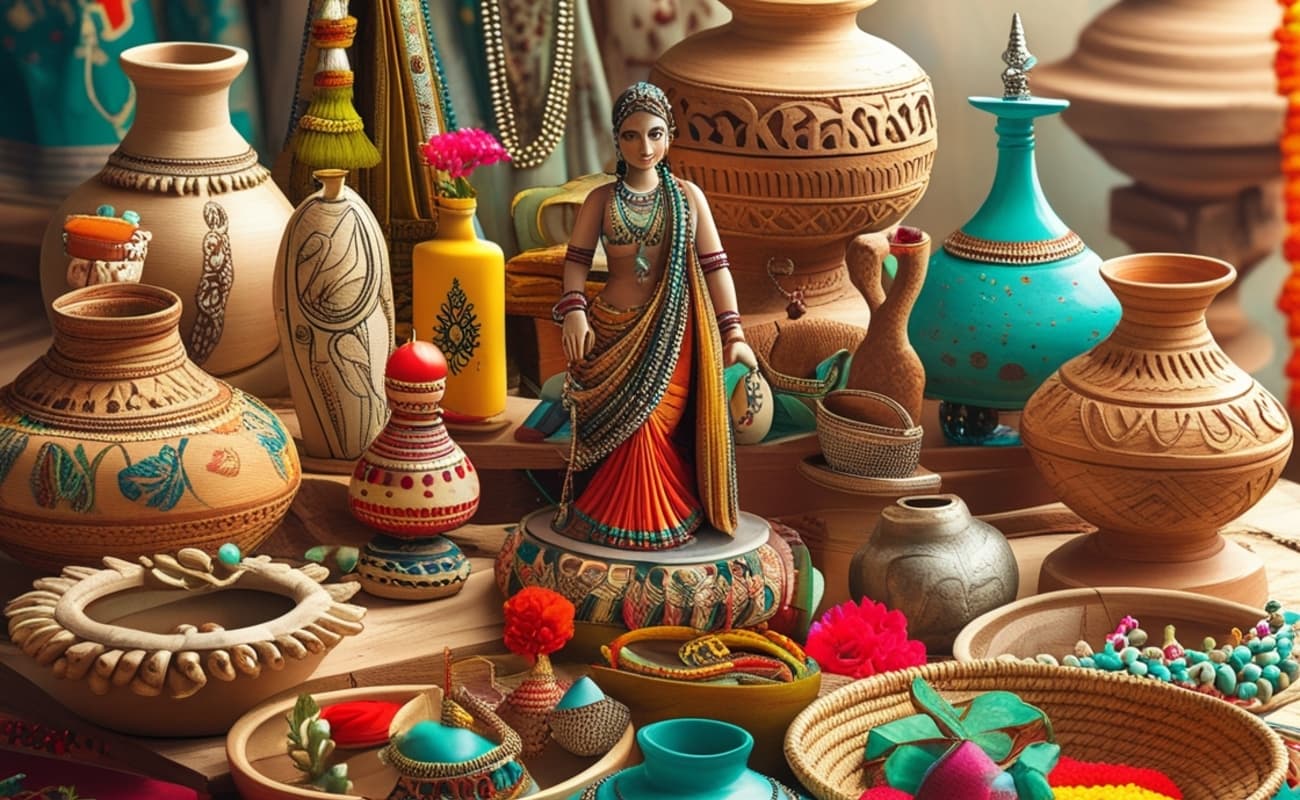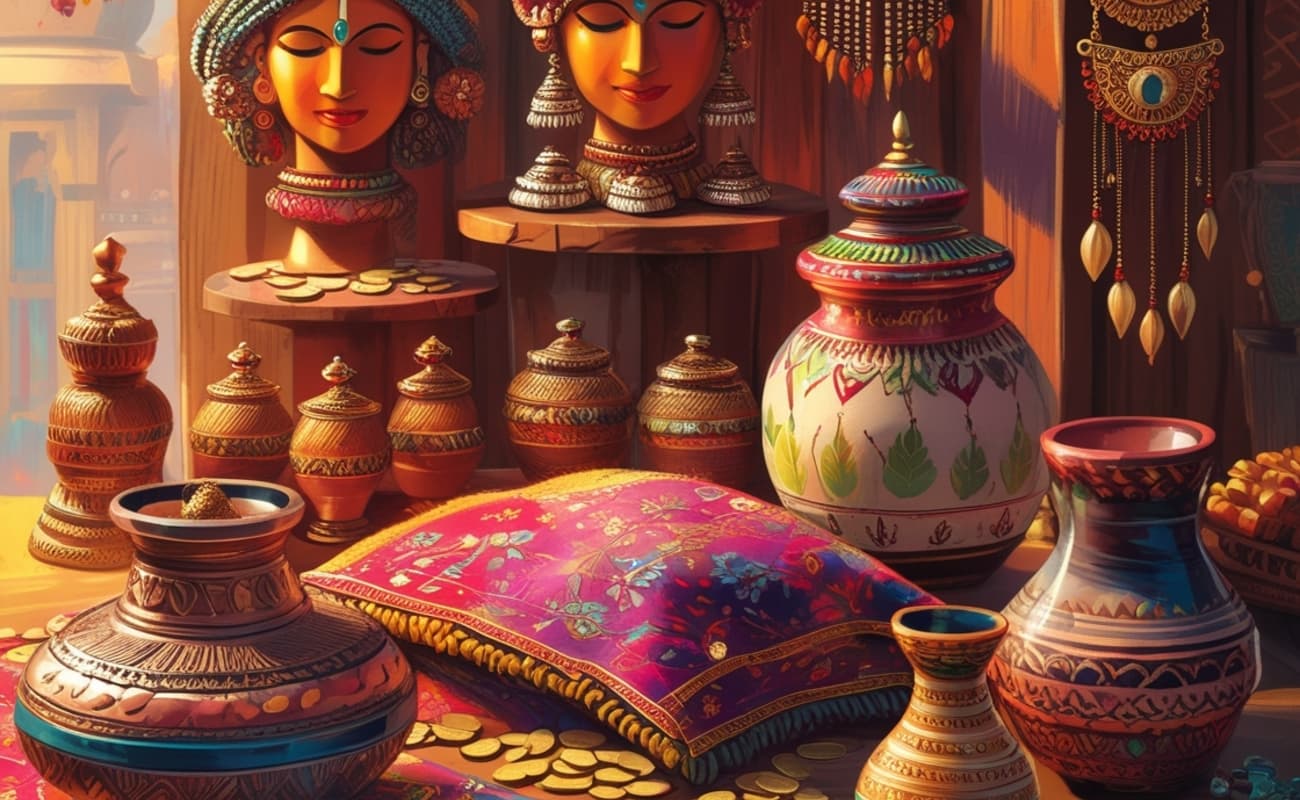Welcome to a vibrant journey through the rich world of Indian handmade products. India’s diverse culture and history have nurtured a wealth of artisanal traditions—from the intricate Banarasi textiles to the enchanting Madhubani paintings—each piece carrying a tale of heritage and authenticity. Have you ever wondered about the craftsmanship behind these treasures or the challenges modern artisans face in a digital era?
Before diving deeper into our exploration, feel free to visit our homepage for more insights and inspiration.
A Glimpse at the World of Indian Artisan Goods
| Artisan Product | Region/Origin | Unique Features |
|---|---|---|
| Banarasi Textiles | Varanasi, Uttar Pradesh | Intricate weaving, gold and silver brocade |
| Rajasthani Handicrafts | Rajasthan | Vibrant pottery, mirror work, and block prints |
| Madhubani Paintings | Bihar | Intricate folk art style, narrating local legends |
| Terracotta Figures | Various regions | Hand-sculpted, culturally significant motifs |
Challenges Faced by Local Artisans
Despite the timeless appeal of Indian Handmade Products, local Indian artisans encounter numerous challenges in today’s fast-paced market. The major hurdles include:
Firstly, fierce competition with mass-produced items often undermines the economic viability of these traditional crafts. With the influx of industrially made goods, it becomes a strenuous task for artists to preserve originality while keeping their work accessible and affordable. Secondly, limited access to modern digital marketing tools hinders their ability to reach a global audience. Many talented craftsmen struggle to harness social media and e-commerce strategies essential for expanding their market for Indian Handmade Products. Lastly, the delicate balance between innovation and maintaining authenticity can sometimes blur the true cultural significance of these ancient skills, which are inherent in Indian Handmade Products.

Strategies for Thriving in a Modern Marketplace
In tackling these challenges, innovative techniques and platforms are emerging as key solutions. Modern artisans are now embracing digital channels and becoming active on established online marketplaces such as Craftsvilla and Etsy. These platforms not only offer a global stage but also allow sellers to blend tradition with contemporary trends.
Integrating Digital Innovation with Traditional Artistry
By leveraging a mix of traditional storytelling and modern digital marketing, artisans can captivate both local and international audiences with Indian Handmade Products. Many sellers share the fascinating histories behind their crafts, creating an intimate connection with buyers. Moreover, partnerships with ethical and luxury brands have emerged to elevate the market presence of these Indian Handmade Products. This kind of collaboration emphasizes sustainability and transparency—qualities that resonate strongly with today’s conscious consumers.
Harnessing the Power of Geographical Indications (GI) and Awareness Campaigns
The Role of Storytelling in Promoting Indian Handcrafted Goods
Isn’t it intriguing how a simple narrative can transform an ordinary transaction into an emotional experience? Storytelling is a powerful tool that artisans are increasingly harnessing to breathe life into their Indian Handmade Products.
Imagine knowing the generations of expertise that culminated in crafting a delicate piece of pottery or the meticulous hours spent weaving intricate silk patterns into a Banarasi textile. Such insights foster a deeper appreciation and often inspire buyers to support these traditional Indian Handmade Products with renewed enthusiasm. When you shop for unique Indian Handmade Products, you’re not just buying an object—you’re investing in a legacy.
Exploring the Diversity of Indian Craftsmanship
Indian artisanal traditions are numerous and diverse, encompassing everything from vibrant, showy regional works to understated, subtle objects that whisper secrets of centuries past. The appeal of these timeless products lies in their individuality and the ethical principles that lie behind each and every step in their production.
Most young entrepreneurs and craft collectors are now more drawn to these products for the unique charm that they provide. Their natural uniqueness and the touch of human individuality in presentation make them a great option for fashionable fashion statements, sophisticated home decor, or personalized gifts. The renewed interest in sustainability and ethical consumption trends further solidifies the position of Indian handcrafted products in today‘s global economy.
Real Stories from the Field
Artisans throughout India have impressive stories that say a lot regarding their perseverance and commitment. One such story is that of a young craftsman from Rajasthan who not only mastered traditional skills imparted to her generation by her family but also utilized digital media to sell her exquisite mirror-work jewelry. Overwhelmed at first by the sheer challenge of scaling her operations, she finally succeeded by teaming up with global platforms and stressing on the authenticity of her craftsmanship.
These stories encourage millions more, proving that when cultural heritage and contemporary innovation are combined, the results can be nothing short of revolutionary. Have you ever purchased a handmade item due to the story behind it? This combination of tradition and imagination shows the future promise of Indian handmade products.

Strategic Insights for Aspiring Sellers
If you’re considering entering the realm of artisanal products or even looking to sell your own handmade treasure, it’s essential to adopt a balanced approach. In my own experience exploring and selling handmade products online, I found that a thorough understanding of both the cultural backdrop and modern digital strategies is key. For more detailed advice on entering this market, check out our guide on how to sell handmade products online?
Future Directions in the Indian Handicraft Industry
In the future, a number of strategic moves are likely to characterize the growth of Indian handcrafted products. The ongoing innovation in marketing technology and growing consumer pressure for eco-friendly products are two prime movers of this shift. With initiatives like “Vocal for Local” raising national pride, and the widening application of GI tags, the prospects for artisans devoted to quality and tradition look bright.
Additionally, continued partnerships between local artists and high-end brands are leading to exciting new product lines that both premium and new markets can demand. Not only does this two-way market serve to boost revenue but also guarantees that classic methods never lose their place in an increasingly modernized world.
Conclusion
In conclusion, the world of Indian handmade products is a treasure trove of cultural richness and artisanal finesse. From exquisite fabrics and vibrant pottery to inimitable paintings and sculptures, each product boasts a unique story that encapsulates centuries of heritage and innovation. The challenges faced by local craftsmen, from competing with mass-produced items to adapting to digital marketing strategies, are gradually being overcome with a mix of traditional storytelling and modern technological integration.
Whether you are a buyer eager to add a touch of authenticity to your lifestyle or an artisan striving to share your craft with the world, these products offer a distinctive and ethical choice. So, why not dive into this fascinating realm where every purchase supports a legacy and every piece speaks volumes about India’s rich cultural heritage?
FAQ
What are some of the best handicraft websites in India?
The market for Indian handmade products is thriving with several excellent platforms. Websites like Craftsvilla and Etsy provide great exposure for these items. Additionally, keeping an eye on curated seller accounts like The India Craft House on various platforms can guide you in discovering authentic pieces.
Where can I find authentic Indian handicrafts online?
If you are looking for Indian handmade products online, websites specializing in artisanal crafts offer a rich selection. Trustworthy sites often highlight the story behind each product, ensuring not only authenticity but also ethical sourcing and fair compensation for the artisans.
What is The India Craft House seller account?
The India Craft House seller account is an online platform where curated collections of authentic Indian handicrafts are showcased. It emphasizes quality and tradition, providing buyers with products that carry a piece of India’s cultural heritage. This account is highly recommended for those seeking unique, ethically produced crafts.
How do Geographical Indications (GI Tags) benefit local artisans?
GI Tags help certify the authenticity of products by highlighting their region-specific craftsmanship. This not only protects traditional methods but also boosts market confidence and adds value to the artisan products, ensuring that the unique heritage of each item is recognized internationally.
How can I support ethical and traditional Indian crafts?
One of the best ways to support ethical Indian crafts is by purchasing directly from reputed sources and platforms that are dedicated to preserving artisanal traditions. By learning the story behind each product and sharing it, you become an ambassador for these cultural treasures, ensuring that local craftsmanship thrives in an ever-changing global market.
